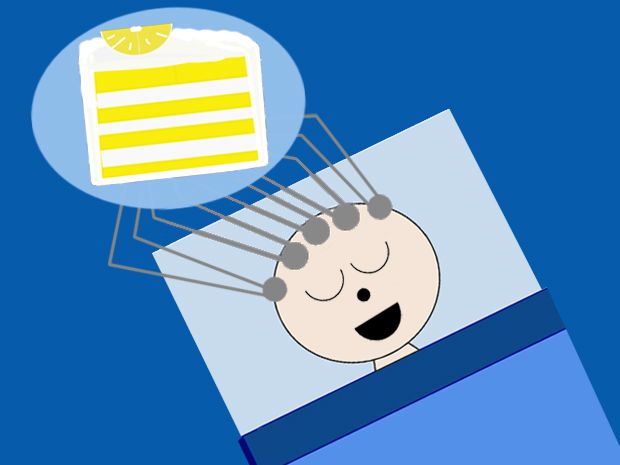New research released on Sunday suggests that lucid dreaming may be triggered by a non-invasive neural stimulation method called transcranial alternating current stimulation (tACS), which targets low-intensity electricity through the frontal and temporal lobes of the dreamer.
I can see this rapidly becoming a DIY product for the spiritual and self-enhancement markets. But there is also potential (especially in PTSD) to give those suffering nightmares a way to "reframe" the dreamscape.
Pretty cool.
As usual, the full article is safely ensconced behind a paywall to keep the riffraff from having access, so here is the abstract, followed by a summary from IEEE Spectrum.
Full Citation:
Voss, U, Holzmann, R, Hobson, A, Paulus, W, Koppehele-Gossel, J, Klimke, A & Nitsche, MA. (2014, May 11). Induction of self awareness in dreams through frontal low current stimulation of gamma activity. Nature Neuroscience; doi:10.1038/nn.3719
Here is the summary of the research from IEEE Spectrum:Induction of self awareness in dreams through frontal low current stimulation of gamma activity
Ursula Voss, Romain Holzmann, Allan Hobson, Walter Paulus, Judith Koppehele-Gossel, Ansgar Klimke & Michael A Nitsche
Abstract
Recent findings link fronto-temporal gamma electroencephalographic (EEG) activity to conscious awareness in dreams, but a causal relationship has not yet been established. We found that current stimulation in the lower gamma band during REM sleep influences ongoing brain activity and induces self-reflective awareness in dreams. Other stimulation frequencies were not effective, suggesting that higher order consciousness is indeed related to synchronous oscillations around 25 and 40 Hz.
Zapping Sleepers' Brains Causes Lucid Dreaming
By Eliza Strickland
Posted 12 May 2014
 Illustration: Randi Klett
Illustration: Randi Klett
Lucid dreams offer us the heady chance to shape our own fates in a fantasy world. In these dreams, sleepers realize they're dreaming and can sometimes take over their dreams' plots, allowing them to turn the tables on their enemies, soar into the sky, or embrace that special someone. Now, researchers in Germany have demonstrated that they can trigger lucid dreams by zapping sleeping people's brains with electricity.
The researchers used a non-invasive neural stimulation method called transcranial alternating current stimulation (tACS) to send low-intensity electricity through the frontal and temporal lobes of 27 sleepers' brains. These portions of the cerebral cortex are associated with higher order cognitive functions, the researchers write, such as self-reflective awareness, abstract thinking, volition, and metacognition (thinking about thinking). Prior studies have shown that these brain regions are dormant during typical REM sleep, when dreams occur, yet are active during lucid dreams.
The tACS stimulation doesn't cause any noise or sensation, so it could be applied to the sleepers without waking them up. The researchers waited until their monitors showed that the subjects were in REM sleep, turned on the current, then woke them up and asked them about the dreams they were having. The test subjects, none of who had experience with lucid dreaming, rated their dreams on factors like insight into the fact that they were dreaming, control of the dream plot, and dissociation, as if they were watching the dream from a third-person perspective.
Not every jolt of electricity produced a lucid dream report. Crucially, the researchers discovered that the effect depended on the frequency of the stimulation. Using the frequency of 40 Hz, researchers found that 77 percent of the reported dreams were rated lucid. At the frequency of 25 Hz, 58 percent of dreams met the criteria, while other frequencies (2, 6, 12, 70, and 100 Hz) produced a much smaller effect or no effect at all. This makes sense, the researchers say, because prior studies that have recorded the activity of the fronto-temporal lobes during lucid dreams have detected neural oscillations (patterns of neural activity) at the gamma frequency band, centered around 40 Hz. It seems stimulation at that frequency mimicked the brain mechanism that can naturally cause lucid dreams.
But enough with the science, let's hear about those test subjects' dreams. Here are two reports from the paper:
Example of lucid dream report following 40-Hz stimulation: I was dreaming about lemon cake. It looked translucent, but then again, it didn’t. It was a bit like in an animated movie, like The Simpsons. And then I started falling and the scenery changed and I was talking to Matthias Schweighöfer (a German actor) and two foreign exchange students. And I was wondering about the actor and they told me “yes, you met him before,” so then I realized “oops, you are dreaming.” I mean, while I was dreaming! So strange!Neural stimulation is all the rage these days. A DIY community has sprung up around transcranial direct current stimulation (tDCS), a method similar to that used by the German researchers. Brain hackers are experimenting with using tDCS to tweak their cognition in various ways, such as improving memory and speeding up learning. In labs around the world, researchers are also investigating whether tDCS can be used to treat a wide variety of disorders, including depression, ADHD, and chronic pain. The age of brain zapping is upon us!
Example of a non-lucid dream report (6 Hz): I am driving in my car, for a long time. Then I arrive at this place where I haven’t been before. And there are a lot of people there. I think maybe I know some of them but they are all in a bad mood so I go to a separate room, all by myself.
No comments:
Post a Comment